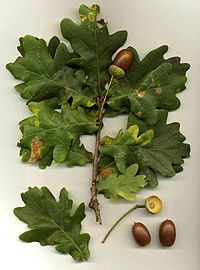
Photo from wikipedia
Tree species distribution, and hence forest biodiversity, relies on the reproductive capacity of trees, which is currently affected by climate change. Drought-induced pollen sterility could increase as a consequence of… Click to show full abstract
Tree species distribution, and hence forest biodiversity, relies on the reproductive capacity of trees, which is currently affected by climate change. Drought-induced pollen sterility could increase as a consequence of more intense and more frequent droughts projected for temperate and Mediterranean regions, and threaten the sexual regeneration of trees in these regions. To evaluate this possibility, we examined the effect of long-term partial rainfall exclusion (-27% precipitation) on male reproductive development in holm oak, Quercus ilex, one of the most important and widespread tree species of the Mediterranean region. We examined anther area, pollen production, pollen abortion as well as viable pollen production in control and dry treatments. Microscopic examinations revealed significant differences in pollen development between trees in the dry and the control treatments, even though anthesis occurred before the onset of annual drought. Our results demonstrate that anthers collected from Q. ilex trees in the dry treatment, which experienced long-term increased drought stress especially during the summer, were the same size as anthers in the control treatment, but displayed 25% pollen abortion and almost 20% reduction in pollen production. Subsequently, the number of viable pollen grains in anthers from dry treatment was 35% less than in control. These results suggest a carry-over effect of drought stress on pollen production that could reduce the reproductive success of Q. ilex. The results have broad implications for better understanding of the determinants of tree reproduction by masting and anticipate the outcomes of expected drought increase in the Mediterranean on forest dynamics.
Journal Title: Plant biology
Year Published: 2018
Link to full text (if available)
Share on Social Media: Sign Up to like & get
recommendations!